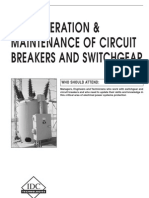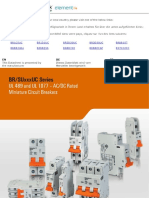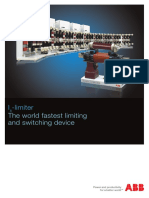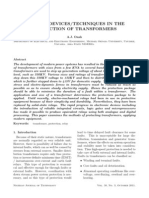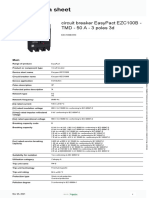The basics of selectivity (discrimination) between circuit breakers
electrical-engineering-portal.com/selectivity-between-circuit-breakers
Google+
The basics of selectivity (discrimination) between circuit breakers (photo credit: elstarelectric.pl)
What is the selectivity?
On economical grounds and for the reason of reliability of the service, it is not always ideal to interrupt the supply to
the installation in the case of a fault as fast as possible . Thats why we have the selectivity between protective
devices.
So what is the selectivity? The whole point of the selectivity is that the protective device immediately upstream of the
fault must respond at first. Only the faulty part of the installation should be isolated. All the other switching and
protective devices connected to the system should remain operative.
Selectivity reduces the duration of a fault and limits its possible damaging effect only to a part of the installation. The
service interruption is reduced to a minimum.
Lets discuss now about two types of selectivity between circuit breakers //
Current selectivity
Time selectivity
1/4
�Current selectivity
In a distribution network, the ratings of the distribution circuit breakers will be smaller and smaller as we go
downstream from the transformer to the load. Similarly, the settings of the short circuit magnetic releases will be also
lower and lower. At the same time, the magnitude of the short circuit current which may occur will be also progressively
lower.
This results in a sort of natural selectivity depending on the magnitude of the short circuit current.
The principle of current selectivity is applied mostly for distribution feeders at the extremity of the
system, with appreciable reduction of the short circuit current due to the long length of the leads.
The prospective short circuit current at the location of installation of the circuit breaker must be known.
Two circuit breakers are mutually selective if the short circuit current flowing through the downstream breaker is lower
than the (adjustable) threshold of tripping of the magnetic release of the unit connected upstream. This value is
considered as the limit of selectivity.
Whether two circuit breaker are really mutually selective is checked by comparing the time-current characteristics
of the breakers. The tripping characteristics of the two breakers may not touch or intersect each other up to the
maximum value of the permissible fault level.
There must be a definite spacing between the two characteristics, depending on the permissible tolerance band
of the releases of the breakers.
Although the method of comparison of the time-current
characteristics is exact, it is also time consuming. The
published tables of the manufacturers, indicating the
selectiveness of the circuit breakers among one another
makes the selection easier.
Figure 1 Time-current characteristics of two current-selective
circuit breakers
As far as overload is concerned, the thermally delayed
bimetallic overload releases of the circuit breakers with
different rated currents are always selective to one another.
The tripping times of the different ratings of the circuit breakers
for the same overload currents are automatically different (as
for example the 100 A version and the 6.3 A version).
Go back to Selectivity Types
Time selectivity
If current selectivity can not be achieved, as for example
between two quick acting circuit breakers having practically
the same reaction time, selectivity is to be realised via the
adjustable delay time of the breakers.
The time selectivity in the case of large circuit breakers for the
2/4
�protection of installations is realised by delaying the magnetic
tripping time by a few half cycles. The total clearing time of the
downstream circuit breaker must be shorter than the minimum
necessary duration of the command time of the circuit breaker
connected immediately upstream.
In other words, for mutually selective circuit
breakers acting in time staggered sequence The
delay time of the upstream circuit breaker must be
longer than the total clearing time of the circuit breaker
connected downstream.
The minimum delay time that can be realised between the time
staggered circuit breakers are 60 or 100ms. The tripping
characteristic of the delayed breaker is shifted upwards on the
published time-current characteristic diagram.
The time selectivity between circuit breakers reacting in a time
staggered sequence is achieved by not allowing the
contacts or the magnetic release to react directly with the
short circuit current. A mechanically delaying mechanism or
an electronic circuit delays the action of the circuit breaker.
For the upstream circuit breaker, one can no longer speak
about a quick acting, current limiting interruption. More than
one half cycles of the actual short circuit current flows
through the delayed acting protective device and also
through the installation. This, obviously, is to be designed
accordingly to withstand this stress.
Figure 2 Time-current characteristics of two time-selective circuit
breakers
Go back to Selectivity Types
Reference // Basics of circuit breakers by Rockwell
Automation
3/4
�4/4
















